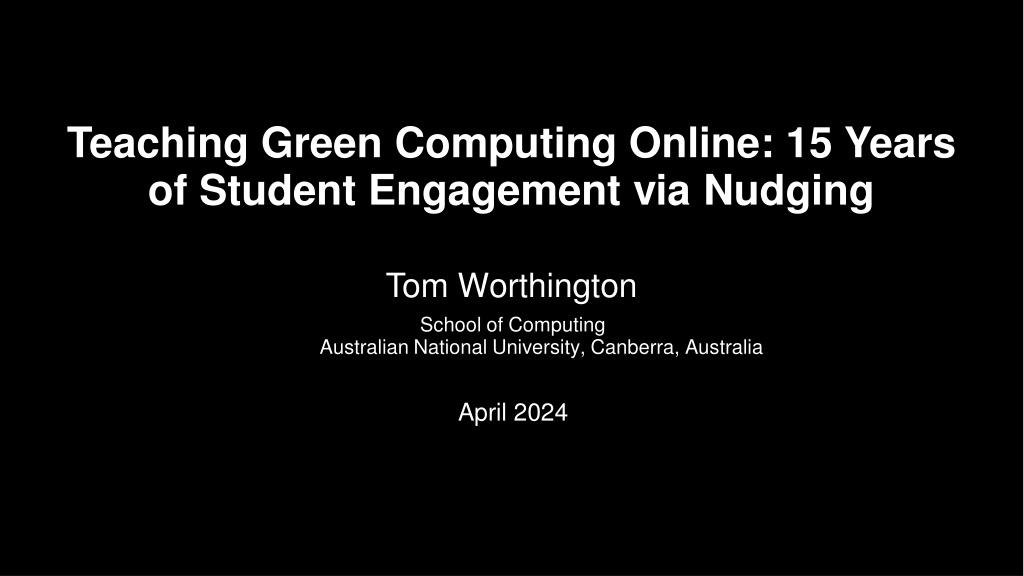Teaching Green Computing Online: 15 Years of Student Engagement via Nudging
Delve into Tom Worthington's innovative approach to teaching green computing online, spanning 15 years of successful student engagement through gentle nudges. Explore the evolution of the course, from its inception to its current structure, designed to combat global warming through ICT CO2 reduction strategies. Discover the unique format, delivery method, and assessment components that make this course both effective and impactful in promoting environmental sustainability in the realm of computing education.
Download Presentation

Please find below an Image/Link to download the presentation.
The content on the website is provided AS IS for your information and personal use only. It may not be sold, licensed, or shared on other websites without obtaining consent from the author. Download presentation by click this link. If you encounter any issues during the download, it is possible that the publisher has removed the file from their server.
E N D
Presentation Transcript
Teaching Green Computing Online: 15 Years of Student Engagement via Nudging Tom Worthington School of Computing Australian National University, Canberra, Australia April 2024
Tom Worthington Honorary Lecturer, Computer Science ANU Professional Education Governance committee member, Past President, Honorary Life Member & Fellow of the Australian Computer Society Fellow of Advance HE (UK) Life member IEEE Blogs as the Higher Education Whisperer 2
Learning to Combat Global Warming Desktop computer clipart, CC 0 AJ from openclipart.org Sun by David Vignoni, GNU Lesser General Public License Factory by Howard Cheng, Public domain, via Wikimedia Commons Computers > electricity > fossil fuel > CO2 > global warming. 3
Green Computing Course How to measure and reduce ICT s CO2 Commissioned in 2008 by ACS Designed by Tom Worthington First run February 2009 by ACS & through OUA For ANU masters students from July 2009 For Athabasca University (Canada) from 2011 and still running. Course available free under a CC licence. Wade Johanson from Canberra, Australia, CC BY 2.0 via Wikimedia Commons 4
Format Traditional distance education online course. 12 weeks, One topic per week, One small assessment per week, Two large assignments. Symbol for pollutants, from directive 67/548/EWG of European Chemicals Bureau. 5
Delivered as Text Moodle eBook. One chapter per week. One exercise at the end of each chapter. Default HTML used, allowing for transfer of content from ACS to ANU to Athabasca. Brian Stewart, Chief Information Officer, Simon Fraser University. Adapted the course when at Athabasca. 6
Assessment: Where the magic happens Weekly forum contribution: 20% Questions and answers to the online forum Mark and feedback each week from the tutor Written assignments: mid and end: 80%. Athabasca University Library, Mags55, CC BY-SA 3.0 7
Students Pay Attention to Assessment Students pay attention to feedback accompanied by marks. 2% is sufficient to nudge the students. Tutors are provided with suggested posts to students, & boilerplate replies. The ANU Techlauncher program turbocharges feedback from students, tutors, & clients, with a bespoke system & ties it to grades grades. ANU TechLauncher Showcase 2019. 8
Questions & More Information Cochrane, T. D., Narayan, V., Aiello, S., Alizadeh, M., Birt, J., Bone, E., Cowie, N., Cowling, M., Deneen, C., Goldacre, P., Sinfield, D., Stretton, T., & Worthington, T. (2022). Analysing mobile learning designs: A framework for transforming learning post-COVID. Australasian Journal of Educational Technology, 38(4), 1 21. https://doi.org/10.14742/ajet.7997 TechLauncher: https://cs.anu.edu.au/TechLauncher/current_students/ Learning to Reflect Module for TechLauncher, Blog posts 2018 to 2022, with drafts, & commentary: https://www.tomw.net.au/technology/education/learning_to_reflect/ Tom Worthington, ANU Research School of Computer Science: tom.worthington@anu.edu.au 9
Over to You Here are four questions to discuss: 1. What have you done to improve online student engagement? 2. What level of granularity is best for feedback to students: hourly, daily, weekly, monthly? 3. Do students get tired of boilerplate replies? 4. Will they get annoyed by AI generated feedback? ASCILITE ML-SIG brainstorming a presentation using a real time tool (Padlet). Please type a reply to at least one using the tool provided, and comment on at least one other reply. 10


























